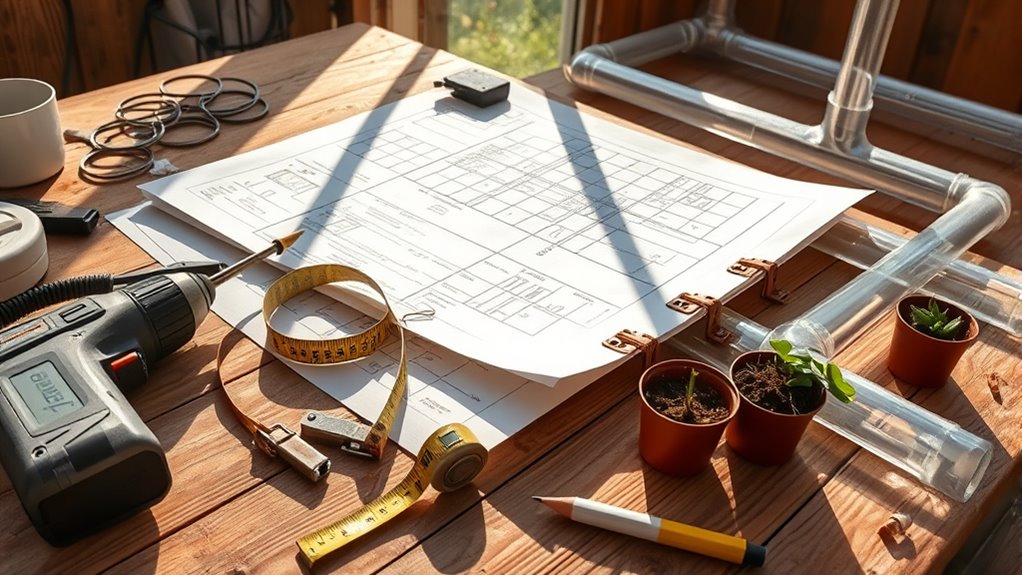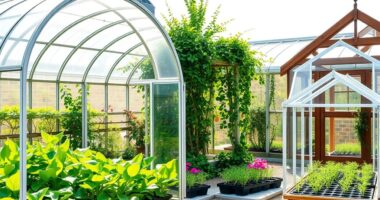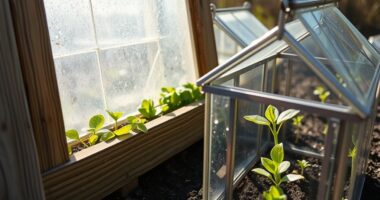To budget for your DIY greenhouse, start by estimating all necessary materials like framing, glazing, and foundation, then compare prices from various suppliers online and locally. Consider using reclaimed or recycled materials to save costs without sacrificing quality, and explore bulk or wholesale purchasing options. Balance your spending between affordable options and durable choices to reduce long-term maintenance. Keep exploring for more tips to make your project both budget-friendly and lasting.
Key Takeaways
- Conduct detailed cost estimations for all materials, including frame, glazing, foundation, and ventilation before purchasing.
- Compare prices from multiple vendors and consider wholesale or bulk buying to reduce material costs.
- Choose durable, cost-effective materials like reclaimed wood, polycarbonate, or PVC piping to balance budget and longevity.
- Prioritize essential components and explore alternative options to cut expenses without compromising functionality.
- Factor in long-term maintenance costs to ensure your budget accounts for durability and reduced future expenses.

Building a greenhouse on a budget starts with careful planning and smart budgeting. When you begin, the first step is to do a thorough cost estimation. This means you need to figure out exactly how much everything will cost before you buy a single piece of material. Start by listing all the essential components: the frame, glazing, foundation, ventilation, and any additional accessories like shelving or automatic vents. Once you have a detailed list, research prices online or at local suppliers to get a realistic idea of what each item will cost. This way, you can identify areas where you might cut costs or consider alternative options. For example, if certain high-end materials are too expensive, look for more affordable yet durable substitutes that still meet your needs.
Material selection plays a vital role in keeping your project within budget. Choosing the right materials not only affects the initial costs but also impacts the greenhouse’s longevity and maintenance expenses. For the frame, options range from inexpensive wood to more durable metal or PVC piping. Wood is often the most budget-friendly, especially if you can find reclaimed or recycled pieces, but keep in mind it may require more maintenance over time. Metal frames tend to be more expensive upfront but last longer and require less upkeep. When it comes to glazing, you have several choices: polycarbonate panels, polyethylene film, or glass. Polyethylene film is the most affordable but might not last as long; polycarbonate is a good middle ground, offering durability at a moderate price. Glass, while traditional and aesthetically pleasing, tends to be the priciest and heavier to handle, so consider your budget and climate when making your choice.
As you select materials, always compare prices from different vendors and consider bulk purchases when possible. Sometimes, buying in larger quantities or from wholesale suppliers can greatly reduce costs. Additionally, don’t overlook the potential of using recycled or repurposed materials, which can save money and add character to your greenhouse. Keep in mind that cheaper materials might save you money upfront but could lead to higher maintenance costs or shorter lifespan. Weigh the upfront savings against long-term durability to make the most cost-effective decision for your budget. Incorporating cost-effective options and flexible supply sources can further optimize your overall expenses.
Frequently Asked Questions
What Are the Most Cost-Effective Materials for a DIY Greenhouse?
You should opt for cost-saving insulation options like recycled plastic bottles or bubble wrap to keep expenses low. For framing, affordable options such as wood or PVC pipes work well and are easy to assemble. These materials not only save money but also provide effective insulation and stability. By choosing these budget-friendly materials, you can build a functional greenhouse without overspending, making your project more sustainable and achievable.
How Can I Reduce Ongoing Maintenance Costs?
Think of your greenhouse as a well-tuned engine—keeping it running smoothly saves you money. To cut ongoing costs, invest in energy-efficient systems like LED grow lights and insulation, which lower your utility bills. Also, implement pest control strategies such as natural predators or organic repellents to avoid costly chemical treatments. Regular maintenance and proactive troubleshooting help prevent bigger issues, ensuring your greenhouse stays thriving without draining your wallet.
Are There Any Grants or Subsidies for Greenhouse Projects?
You should explore government grants and environmental subsidies available for greenhouse projects. Many local, state, or federal programs support sustainable initiatives, so check with your local government or environmental agencies. Applying for these grants can help cover costs and reduce your financial burden. Be sure to gather all required documentation and meet eligibility criteria to increase your chances of securing funding.
How Do Seasonal Changes Affect My Greenhouse Budget?
Seasonal changes impact your greenhouse budget by influencing seasonal planting needs and heating considerations. During colder months, you’ll spend more on heating to maintain ideal temperatures, increasing costs. Conversely, in warmer seasons, you may need less heating and possibly invest in shading or ventilation. Planning ahead for these fluctuations helps you allocate funds wisely, ensuring you can sustain your plants year-round without overspending.
What Safety Equipment Is Essential for Construction and Operation?
Ever wonder how you can stay safe while building and running your greenhouse? You need protective gear like gloves, safety glasses, and sturdy footwear to shield yourself during construction. Follow safety protocols diligently, including proper tool handling and ventilation practices. Do you want to avoid accidents and ensure smooth operation? Prioritize essential safety equipment to safeguard yourself and make your greenhouse project enjoyable and safe from start to finish.
Conclusion
Think of your DIY greenhouse as a seed you plant today—careful budgeting nurtures its roots, ensuring it grows strong and fruitful. Every dollar saved is like water, fueling your vision. With patience and planning, your small investment becomes a lush oasis, symbolizing hope and growth. As the sun nourishes your plants, your smart choices will illuminate your path to a thriving, self-sufficient garden—proof that careful budgeting can turn dreams into reality.









